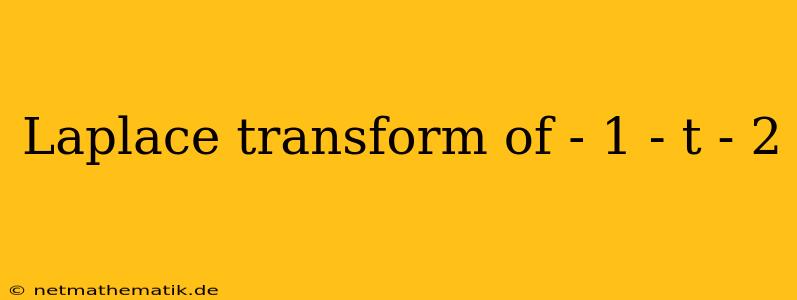The Laplace transform is a powerful mathematical tool used to transform differential equations into algebraic equations, making them easier to solve. It is particularly useful for solving problems involving systems described by linear ordinary differential equations with constant coefficients. In this article, we will delve into the process of finding the Laplace transform of the function $-1 - t - 2t^2$.
Understanding the Laplace Transform
The Laplace transform of a function f(t), denoted as F(s), is defined as:
$ F(s) = \mathcal{L} {f(t)} = \int_{0}^{\infty} e^{-st} f(t) dt $
where s is a complex variable. This integral transforms the function f(t) in the time domain (t) to a function F(s) in the frequency domain (s).
Laplace Transform Properties
Before we calculate the Laplace transform of $-1 - t - 2t^2$, let's recall some useful properties of the Laplace transform:
Linearity: $\mathcal{L} {af(t) + bg(t)} = a\mathcal{L} {f(t)} + b\mathcal{L} {g(t)}$
Time Shifting: $\mathcal{L} {f(t-a)} = e^{-as}F(s)$
Frequency Shifting: $\mathcal{L} {e^{at}f(t)} = F(s-a)$
Differentiation in Time Domain: $\mathcal{L} {f'(t)} = sF(s) - f(0)$
Differentiation in Frequency Domain: $\mathcal{L} {t^nf(t)} = (-1)^n \frac{d^n}{ds^n} F(s)$
Finding the Laplace Transform of -1 - t - 2t²
Now, let's apply these properties to find the Laplace transform of $-1 - t - 2t^2$.
Using the linearity property, we can break down the function into simpler terms:
$\mathcal{L} {-1 - t - 2t^2} = \mathcal{L} {-1} - \mathcal{L} {t} - 2\mathcal{L} {t^2}$
Now, we need to find the Laplace transform of each term individually:
-
Laplace Transform of -1:
Using the definition of the Laplace transform:
$\mathcal{L} {-1} = \int_{0}^{\infty} e^{-st} (-1) dt = -\frac{1}{s}$
-
Laplace Transform of t:
Using the differentiation in the frequency domain property:
$\mathcal{L} {t} = -\frac{d}{ds} \mathcal{L} {1} = -\frac{d}{ds} \left(\frac{1}{s}\right) = \frac{1}{s^2}$
-
Laplace Transform of 2t²:
Using the differentiation in the frequency domain property twice:
$\mathcal{L} {2t^2} = 2(-1)^2 \frac{d^2}{ds^2} \mathcal{L} {1} = 2 \frac{d^2}{ds^2} \left(\frac{1}{s}\right) = \frac{4}{s^3}$
Finally, combining the Laplace transforms of each term, we get the Laplace transform of the entire function:
$\mathcal{L} {-1 - t - 2t^2} = -\frac{1}{s} - \frac{1}{s^2} - 2\cdot \frac{4}{s^3} = \boxed{-\frac{1}{s} - \frac{1}{s^2} - \frac{8}{s^3}}$
Conclusion
Therefore, the Laplace transform of $-1 - t - 2t^2$ is $-\frac{1}{s} - \frac{1}{s^2} - \frac{8}{s^3}$. This result can be useful in solving differential equations involving this specific function, particularly when working in the frequency domain. By understanding and applying the properties of the Laplace transform, we can efficiently transform functions and solve complex problems in various fields like engineering, physics, and mathematics.
